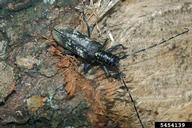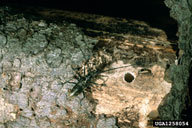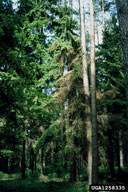Black fir sawyer beetle
Monochamus urussovii (Fischer von Waldheim) (Coleoptera: Cerambycidae)
Orientation to pest
Black fir sawyer beetle, Monochamus urussovii (Fischer von Waldheim), is native to Eurasia and is not present in North America. Male black fir sawyer beetles have antennae approximately twice as long as body, whereas those of females are just a bit longer that the body. This beetle attacks all species in the family Pinaceae. Firs (Abies) are especially vulnerable to damage. It is the capability of M. urussovi to vector phytopathogenic fungi that poses the greatest threat to North American forests. Reproduction of this beetle occurs in weakened or dying trees that have been affected by drought or fire, or have been wind thrown or recently cut. Outbreaks can occur, however, in live, healthy trees. The life cycle begins when beetles feed in the crown, removing strips of bark. This feeding infects branches with the blue-stain fungus Leptographium sibiricum Jacobs and Wingfield. Dieback of branches in the crown weakens the tree and reduces resin flow. These changes make the tree suitable for beetle oviposition and larval feeding. In the summer, female beetles excavate oviposition niches, often in the branches, and lay a single egg beneath the bark. Larvae dig sinuous galleries, up to 2.5 cm wide, under. These galleries are filled with frass. In the spring, overwintered larvae dig into the sapwood and create a pupal chamber, from which adults later emerge. As an infested host tree dies, its needles turn yellow and then red.
Hosts commonly attacked
This species is most damaging to fir (Abies), but larch (Larix), spruce (Picea), pine (Pinus) and birch (Betula) species are also commonly attacked.
Distribution
This beetle occurs in Sweden, Norway, Finland, eastern Poland, Estonia, Latvia, Lithuania, Belarus, Ukraine, Russia, Kazakhstan, Mongolia, northeastern China, Korea, and northern Japan.
Images of black fir sawyer beetle
| Figure 1. Adult of black fir sawyer beetle, Monochamus urussovii | Figure 2. The circular emergence holes of black fir sawyer beetles are large, ca 1.2 cm in diameter | Figure 3. Brown foliage is sign of attack by black fir sawyer beetle |
Important biological control agents related to this pest species
Some information is available in Russian language publications on the natural enemies of this species in Russia (see Isaev et al., 1988).
Web links for information on black fir sawyer beetle
Articles
- Vetrova, V. P., A. S. Isaev, N. V. Pashenova, and N. Yu Konstantinov. 1998. Estimating the threat of a mass outbreak of Monochamus urussovii in the dark coniferous stands of the Lower Angara region after damage by Dendrolimus sibiricus. Lesovedenie 3: 58-67.
- Jacobs, K., M. J. Wingfield, N. V. Pashenova, and V. P. Vetrova. 2000. A new Leptographium species from Russia. Mycological Research 104: 1524-1529.
- Isaev, A. S., T. M. Ovchinnikova, and V. G. Sukhovol'skii. 2001. Modeling the population dynamics of the longhorn Monochamus urussovii in the dark central-taiga forests of Siberia. Lesovedenie 4: 15-24.
- Isaev, A. S., A. S. Rozhkov, and V. V. Kiselev. 1988. The fir longhorn Monochamus urussovi. (Chernyi pikhtovyi usach Monochamus urussovi [Fisch.]). Novosibirsk: Nauka, No. 270 (in Russian)






